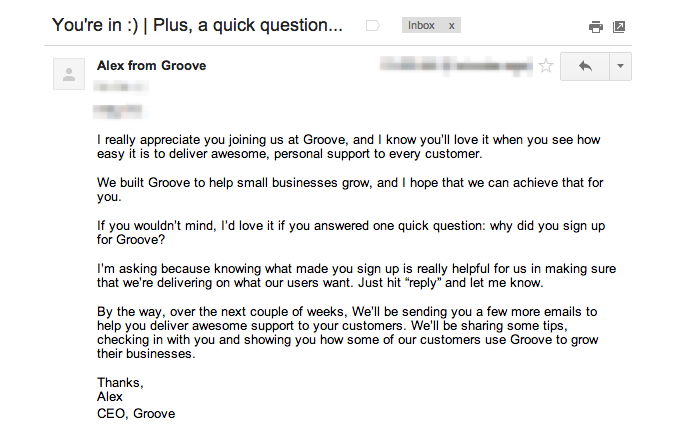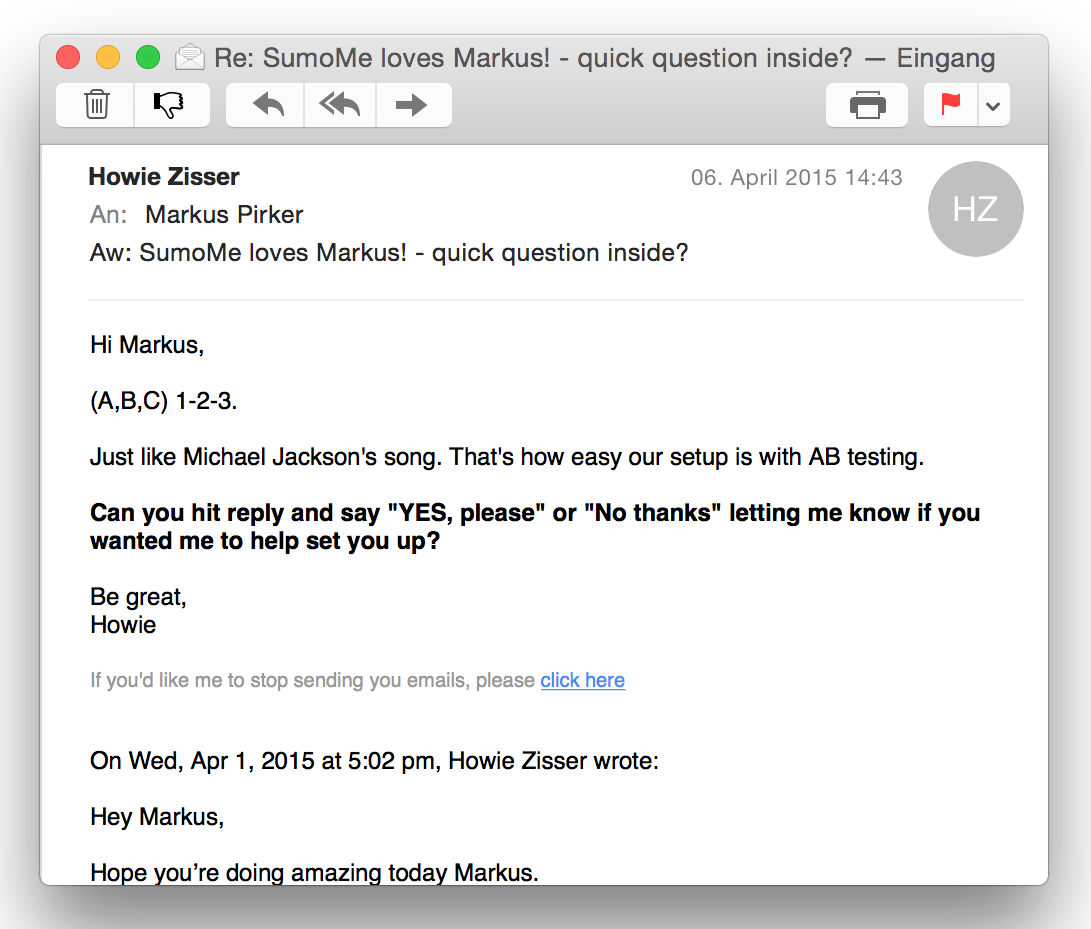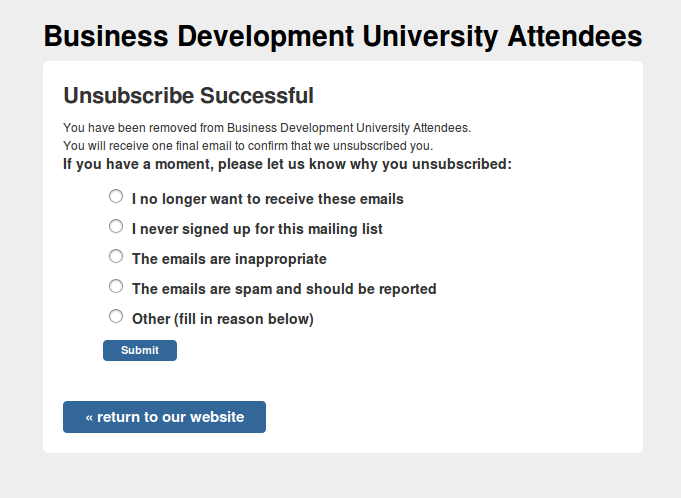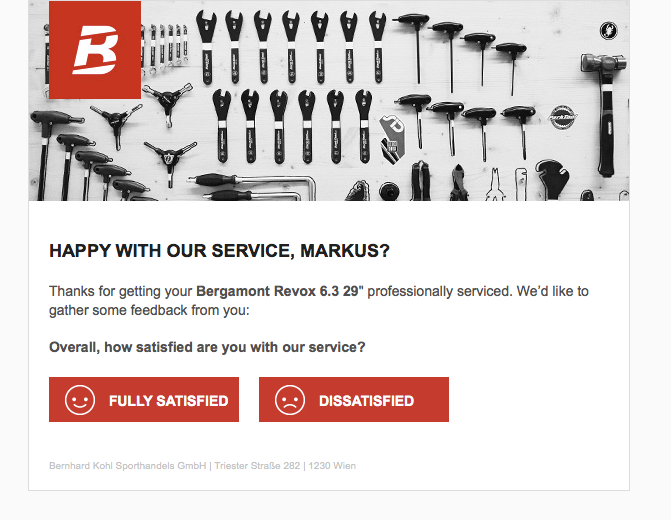I once read a story about a great lecturer. After delivering his presentation he had the habit of asking everyone he had the chance to talk t what his interlocutor had absolutely disliked about his talk.
If people hesitated, he told them that he only had been invited as a speaker today because of his listening to and acting on every single negative feedback he received.
Your most unhappy customers are your greatest source of learning.
— Bill Gates
This is the way people have the chance of being honest, share their experience and give advice.
This single question only took him a few seconds to ask, but it provided him with a stream of tremendously helpful feedback that allowed him to continuously improve his performance.
UX Designer Sarah Doody recently posted an awesome article to the Invision Blog where she calls this kind of quick feedback “micro-feedback“ and explains why it is important for your business.
While she covers the basics perfectly, I would like to take a more practical approach and show you some possible ways of integrating this kind of feedback mechanism into your daily business.
The best kind of research is the kind that you actually do.
— Laura Klein in Tiny Tests: User Research You Can Do NOW!
Something even better is the kind of research that is continuously and automatically done for you.
So I suggest you read on to learn how to set up a working micro-feedback channel for your business.
1. Where to integrate micro-feedback
The first step to add micro-feedback to your business is to look for possibilities.
You’re on the lookout for touch points with your customers which allow you to get the most valuable insights.
Some great customer interactions to gather micro-feedback are:
New customers – Why did you choose us?
Knowing the reason why people are interested in the things you offer is very valuable.
The knowledge about these unique triggers allows you to adapt your marketing efforts to those benefits mentioned most frequently, and to resonate more with your copy.
Alex, CEO of Groove – a customer support tool, sends everyone who signs up the email below, in which he asks a single simple question: Why the person has signed up. (If you haven’t done so already I suggest you read the Groove Blog where they share weekly insights very realizable for your own business.)
 Groove Welcome Email
Groove Welcome Email
According to Alex, this email has a 41% response rate and this single (and automated) email not only provides a continuous stream of new insights for the team, but also helps the team to tailor all future interactions with the specific customer according to his or her unique needs.
This is a tremendous response rate for an email being more a “centi-feedback” than a “micro-feedback” regarding its length.
I would be very interested to learn about the impact on the conversion rate if this email were reduced to half the number of words.
SumoMe also does a great job at offering help after your signup.
In a short, personalized, and text-only email, they ask you to reply “YES, please” or “No, thanks” if you need any help.
 SumoMe: Personalized and short feedback email with a clear call to action.
SumoMe: Personalized and short feedback email with a clear call to action.
Lost Customers – Why did you quit?
Like Bill Gates said, you can learn the most from your unhappy customers.
You most certainly know this feeling of despair when a hard-won customer leaves and you don’t know why.
You want to find out why people cancel their account, unsubscribe from your email list or return their order.
But if someone quits, how high is the probability that he or she will take the time to answer your long and detailed survey, with your fancy business header, sent out automatically from a bot?
In his book, The 7 Day Startup, Dan proposes another way to approach lost customers by sending them a short email to find out why they have canceled.
Subject: Did we do anything wrong?
Body: Hi Customer, we’re sorry that you canceled. Did we do anything wrong? Thanks for giving us a go. Dan and Alex.
Short, realizable, personal. This is how good micro-feedback should look like.
Maybe you have unsubscribed from an email list managed by the MailChimp newsletter service.
If you have, you’re probably already familiar with this site where you’re asked for the reason for unsubscribing.
MailChimp even delivers predefined choices speeding up the process of giving feedback on the customer’s side.
 MailChimp: A clever way to gather micro feedback after someone has unsubscribed
MailChimp: A clever way to gather micro feedback after someone has unsubscribed
Remember: A typical business hears from only 4% of its dissatisfied customers, meaning 96% of your dissatisfied customers don’t voice their complaints (Source).
This means that you should take every single feedback you get from a dissatisfied customer very seriously.
With this type of micro-feedback your responses will be realizable because they’ll help you to highlight areas for optimization and open up a channel of communication with customers you would otherwise consider as lost.
Interested Customers: Why haven’t you signed up?
Imagine for example that you’re sending out a newsletter with a special offer.
Wouldn’t it be interesting to know why those people who clicked on your offer weren’t persuaded to buy in the end?
You can easily integrate this kind of micro-feedback into your existing email campaigns by sending a message to this specific group of subscribers (clicked last campaign, but did not sign up).
Tools like MailChimp even allow automated campaigns that send out these emails automatically after a few days – you just have to set it up once.
You’ll want this email to look personal and short. Emails without any graphics and just a single open-ended question, sent by a real person, work best.
This is the email we send to subscribers (once) from our usability service Userbrain after they’ve clicked on an offer, but did not sign up:
 Userbrain: Short and automated micro feedback email with an open ended question.
Userbrain: Short and automated micro feedback email with an open ended question.
We learned a lot from the (often very long) responses and this feedback channel continuously provides us with new insights — and even more importantly, it establishes a personal connection with the people interested in our service.
Active customers – What can we improve?
Learn how your product fits into the daily business of your customers.
While surveys, chat windows or popups always interfere with the customer experience, KISSmetrics uses another approach without interrupting the flow.
The feedback box is at the bottom of every page when the user is logged into their service.
 KISSmetrics: In page micro feedback without interrupting the customer
KISSmetrics: In page micro feedback without interrupting the customer
Jason, Product Manager at KISSmetrics, states that 30 to 40 users send them feedback using this method each week.
They have received more than 3,000 suggestions since implementing this feature.
Often, these interactions lead to opportunities for deeper customer development discussions around the use of our product.
— Jason Evanish – Product Manager at KISSmetrics
We once helped Bernard Kohl’s bike shop in Austria to improve their customer service. The shop had problems concerning complaints from customers bringing in their bikes for repair.
While revising and improving the service and repair processes, we added a new feedback channel using micro-feedback. This is the email every customer receives 3 days after he or she has picked up the serviced bike:
 Bernhard Kohl: Automated email with micro feedback trigger for every picked up serviced bike
Bernhard Kohl: Automated email with micro feedback trigger for every picked up serviced bike
60% off all customers respond to this email, 30% (of all customers) give a detailed written explanation about their experience concerning the service.
While the shop previously sent out a survey once a year, now every customer is continuously and automatically asked for his or her opinion.
Adding this micro-feedback flow allows you to make ongoing service improvements and helps everyone on the team to follow the voice of the customer closely.
2. The right timing is important
You’re looking for accurate feedback and unbiased answers, so you need to figure out the best time to ask for feedback.
Feedback is best when provided as close to the moment of performance as possible.
— Jeanne C Meister and Karie Willyerd, HBR
In the case of our bike shop, we send out the feedback email 3 days after the customer has picked up his/her bike. So he or she has at least a few days to test the “new” bike to judge the quality of the repair service while the service experience is still vivid and fresh.
For a pizza delivery service, the best timing would probably be 1 hour after the pizza has been delivered.
For a website that is selling online software services, the perfect time would be after visitors have browsed at least through 3 pages to get an idea of the benefits you’re offering to them.
3. Only one question at a time
Always remember that every question you add will dramatically drop the number of people responding.
Since you want to learn from the maximum people possible, the smartest thing to do is to ask only one question.
Remember – it’s called micro-feedback, not bloated survey. Click To TweetIn the case of our bicycle shop, we reduced it to just one question with a Yes or No for answer:
“I am: 1. Satisfied or 2. Unsatisfied with my bicycle repair.”
Over 60% of all people who were asked to give feedback actually responded. This single email continuously streams customer feedback to the CEO and the mechanics of the bike shop.
If you reduce your answers to only a few, pre-selected choices to speed up the process for your customers, make sure to provide a free comment field.
Knowing that 80% of your customers have rated your service as “Very good” in July is fine, but it is even more important to learn WHY the other 20% didn’t like it.
What you’re looking for is realizable feedback, not vanity metrics to put into your next PowerPoint presentation.
4. Follow-up
So, you have created a perfect automated way of getting feedback. What do you do if a customer is unhappy?
Make sure you’re thinking the whole process through and that you are channeling the feedback to the right place. You actually have to act on the insights you receive to improve.
Things to consider after you’ve established your micro-feedback loop:
- Send it to your customer support system, set the right priorities and assign the right person to deal with an identified issue.
- Make sure to include enough details about the case for the support person to act upon it.
- Pass on the information to the people who are actually doing the work challenged (e.g. your developers).
- Encourage your fans to share their positive feedback by providing quick links to social media channels.
In our bike shop, a click on the button “I’m unsatisfied with my repair” instantly generates a support ticket in Zendesk that is assigned to the CEO, who handles each negative feedback in person and gets back to the customer.
The mechanic responsible for that particular bike is automatically informed that there has been an issue and thus can find out how to improve his work on the next bike.
5. Be creative with the method of delivery
Do you remember the story about the great lecturer who asked his audience what to improve after every performance?
You don’t have to stick to emails as the method to receive your micro-feedback.
 Dublin Airport: Great, creative way of integrating micro feedback in the security process. (Image by Sarah Doody)
Dublin Airport: Great, creative way of integrating micro feedback in the security process. (Image by Sarah Doody)
As a manager of a large team, you could ask your employees to tweet you an answer concerning “One thing I could be doing better to make it easier to do my job is …” – as Jeanne C Meister and Karie Willyerd suggest.
6. Summing up Micro Feedback
That fact that you have to listen to customer feedback to deliver a great experience is crystal-clear. But listening to customers is only possible if you allow and encourage them to speak out.
Integrating continuous micro-feedback into your business will help you to develop a new customer-focused approach, improving on your product, making better decisions on new features, and building stronger relationships with your customers.
You can start today.
But, wait!
If you could change one thing about this article, what would it be?
Tweet me
Thanks. 🙂
About the Author: Markus Pirker is Co-Founder of Userbrainand Simplease. You can find him on Twitter at @gabelfisch.
Related Posts
Invision Blog: Get better qualitative data on your user experience with microfeedback
Forbes: Use tiny tests to get fast cheap feeback on your product
HBR: Twitters potential as microfeedback
Client Heartbeat: Customer Feedback: 19 Strategies To Get More Feedback
KISSmetrics Blog: The Secret to Getting Great Feedback from Your Users


